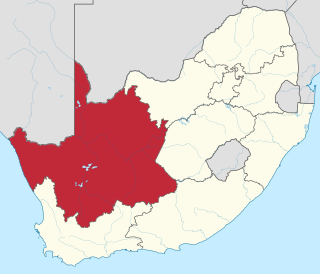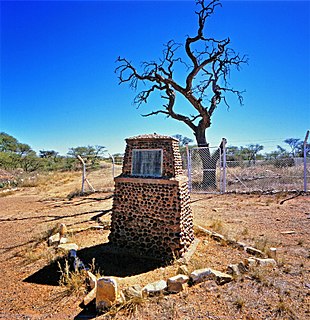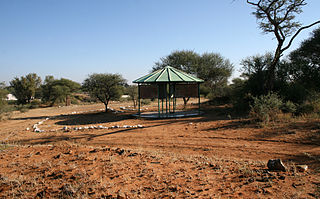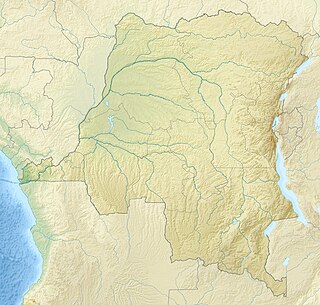
Cave paintings are a type of parietal art, found on the wall or ceilings of caves. The term usually implies prehistoric origin, but cave paintings can also be of recent production: In the Gabarnmung cave of northern Australia, the oldest paintings certainly predate 28,000 years ago, while the most recent ones were made less than a century ago.

The Northern Cape is the largest and most sparsely populated province of South Africa. It was created in 1994 when the Cape Province was split up. Its capital is Kimberley. It includes the Kalahari Gemsbok National Park, part of the Kgalagadi Transfrontier Park, an international park shared with Botswana. It also includes the Augrabies Falls and the diamond mining regions in Kimberley and Alexander Bay. The Namaqualand region in the west is famous for its Namaqualand daisies. The southern towns of De Aar and Colesberg, in the Great Karoo, are major transport nodes between Johannesburg, Cape Town and Port Elizabeth. In the northeast, Kuruman is known as a mission station and also for its artesian spring, the Eye of Kuruman. The Orange River flows through the province, forming the borders with the Free State in the southeast and with Namibia to the northwest. The river is also used to irrigate the many vineyards in the arid region near Upington.

Kathu is a town in South Africa, and the iron ore capital of the Northern Cape province. Its name means "town under the trees", after the Camel Thorn forest it is situated in. The phrase "the town under the trees" was coined by an engineer working in the town in the early-1990s as part of a tourist marketing drive, together with the accompanying graphic. It was intended to be a marketing slogan. The meaning of the word "Kathu" has anecdotically been attributed to a porridge brewed by the local population from the powder found in the pods of the Camel Thorn trees.

Barkly West is a town in the Northern Cape province of South Africa, situated on the north bank of the Vaal River west of Kimberley.

Blombos Cave is an archaeological site located in Blomboschfontein Nature Reserve, about 300 km east of Cape Town on the Southern Cape coastline, South Africa. The cave contains Middle Stone Age (MSA) deposits currently dated at between c. 100,000 and 70,000 years Before Present (BP), and a Late Stone Age sequence dated at between 2000 and 300 years BP. The cave site was first excavated in 1991 and field work has been conducted there on a regular basis since 1997, and is ongoing.

The McGregor Museum in Kimberley, South Africa, originally known as the Alexander McGregor Memorial Museum, is a multidisciplinary museum which serves Kimberley and the Northern Cape, established in 1907.
Thomas N. Huffman is Professor Emeritus of archaeology in association with the University of Witwatersrand in Johannesburg, South Africa. He specialises in pre-colonial farming societies in southern Africa. Huffman is most well known for his identification of the Central Cattle Pattern at Mapungubwe, a pre-colonial state in southern Africa. This, in turn he argued as the main influence in the formation of the Zimbabwe Pattern at Great Zimbabwe. Arguably his seminal contribution to the field was A Handbook to the Iron Age: The Archaeology of Pre-Colonial Farming Societies in Southern Africa (2007), which has contributed to the understanding of ceramic style analysis and culture history focusing on these groups.
Wildebeest Kuil Rock Art Centre is a rock engraving site with visitor centre on land owned by the !Xun and Khwe San situated about 16 km from Kimberley, Northern Cape, South Africa. It is a declared Provincial Heritage Site managed by the Northern Cape Rock Art Trust in association with the McGregor Museum. The engravings exemplify one of the forms often referred to as ‘Bushman rock art’ – or Khoe-San rock art – with the rock paintings of the Drakensberg, Cederberg and other regions of South Africa being generally better known occurrences. Differing in technique, the engravings have many features in common with rock paintings. A greater emphasis on large mammals such as elephant, rhino and hippo, in addition to eland, and an often reduced concern with depicting the human form set the engravings apart from the paintings of the sub-continent.

Wonderwerk Cave is an archaeological site, formed originally as an ancient solution cavity in dolomite rocks of the Kuruman Hills, situated between Danielskuil and Kuruman in the Northern Cape Province, South Africa. It is a National Heritage Site, managed as a satellite of the McGregor Museum in Kimberley. Geologically, hillside erosion exposed the northern end of the cavity, which extends horizontally for about 140 m (460 ft) into the base of a hill. Accumulated deposits inside the cave, up to 7 m (23 ft) in depth, reflect natural sedimentation processes such as water and wind deposition as well as the activities of animals, birds and human ancestors over a period of some 2 million years. The site has been studied and excavated by archaeologists since the 1940s and research here generates important insights into human history in the subcontinent of Southern Africa. Evidence within Wonderwerk cave has been called the oldest controlled fire. Wonderwerk means "miracle" in the Afrikaans language.
The concept of the Northern Cape as a distinct geo-political region of South Africa coalesced in the 1940s when a "Northern Cape and Adjoining Areas Regional Development Association" was formed and the first map featuring the name "Northern Cape" was published. The geographic spread to which the term applied was not fixed until 1994, however, when it attained precise definition as the Northern Cape Province, one of South Africa's nine post-apartheid provinces. Since then there have been boundary adjustments to include parts of the former Bophuthatswana adjacent to Kuruman and Hartswater. Vryburg and Mafikeng, in the north eastern extremity of the former Cape Province - and hence regarded as part of the pre-1994 "Northern Cape" - are excluded, being part, now, of the North West Province.
The Barkly West Museum was established in 2000 in the old Toll House beside the Barkly Bridge which crosses the Vaal River at Barkly West in the Northern Cape, South Africa.

Canteen Kopje is an archaeological site, formally protected as a grade 2 provincial heritage site, and approved in 2017 for re-grading to national status, situated outside Barkly West in the Northern Cape, South Africa. The place was previously known as Klipdrift, meaning stony drift, a translation from a still earlier !Ora name, !a |aub. Canteen Kopje is best known for its long and exceptionally rich Earlier Stone Age sequence, spanning circa >0.5 to 1.7 million years, occurring within gravels exposed in late nineteenth/early twentieth century mining pits. Also attracting attention are more recent archaeological levels in the overlying Hutton Sands, which contain material known as Fauresmith, Middle Stone Age, Later Stone Age, and late Iron Age with evidence of protocolonial/colonial contact and interaction, probably, with nineteenth century diamond diggers.

Border Cave is a rock shelter on the western scarp of the Lebombo Mountains in KwaZulu-Natal near the border between South Africa and Swaziland. Border Cave has a remarkably continuous stratigraphic record of occupation spanning about 200 ka. Anatomically modern Homo sapiens skeletons together with stone tools and chipping debris were recovered. Dating by Carbon-14, amino acid racemisation and electron spin resonance places the oldest sedimentary ash at some 200 kiloannum.
Elizabeth Anne Voigt was director of the McGregor Museum in Kimberley, South Africa, and, as an archaeozoologist, served a term as president of the South African Archaeological Society. In retirement, Voigt was appointed a research associate of the McGregor Museum. She was born in Cape Town on 26 April 1944 and died on 7 April 2010 in Kimberley.
The Kathu Archaeological Complex is a cluster of significant archaeological, principally Stone Age, exposures situated in and near Kathu, a mining town in the Northern Cape Province, South Africa. The sites include a suite of sinkhole exposures, the Kathu Pan sites, north west of the town, the immensely rich spread of artefacts at what is referred to as Kathu Townlands on the eastern side of Kathu, and surface and subsurface horizons including handaxes on farms further eastward.
The South African Archaeological Society was founded in 1945 to promote public awareness of archaeology and its findings in southern Africa, facilitating interaction between professional archaeologists and people with a lay interest in the subject. The society, through its branches, organizes regular lectures and excursions, and, since its inception, has been responsible for publications including a professional journal and a range of newsletters of a more popular nature at national and branch levels. Informally the society is known as "ArchSoc".
Clarence van Riet Lowe was a South African civil engineer and archaeologist. He was appointed by Jan Smuts as the first director of the Bureau of Archaeology and was among the first group to investigate the archaeological site of Mapungube.
Johann Carl "John" Vogel was a South African isotope physicist with a specific interest in archeology for which he used radiocarbon dating to establish timeframes.

Matupi Cave is a cave in the Mount Hoyo massif of the Ituri Rainforest, Democratic Republic of the Congo and northeastern Zaire, where archaeologists have found evidence for Later Stone Age human occupation spanning over 40,000 years. The cave has some of the earliest evidence in the world for microlithic tool technologies.
Kgosi (Chief) Luka Jantjie was a hunter, trader, diamond prospector, and farmer. He was a chief of the Batlhaping ba Manyeding group of the Batswana in Kuruman. He was born in Kimberley, South Africa in 1835 and was the son of a Christian convert. Jantjie spent most of his life protecting the rights to land of his people and is considered a struggle hero for his battle against British colonialism. He was the cousin of Kgosi Galeshewe.









